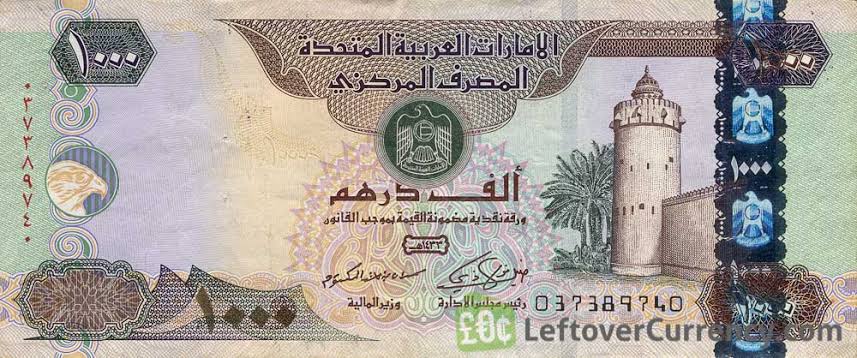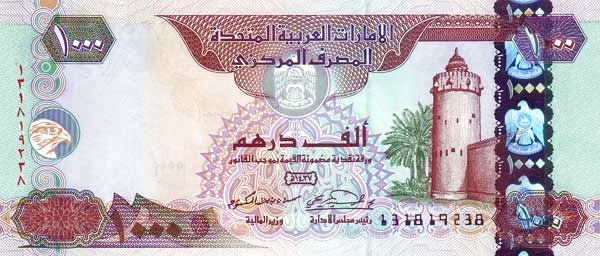The UAE 1000 Dirham Note : The 1000 dirham note is the highest denomination in the United Arab Emirates (UAE) currency system and carries immense significance in the nation’s economy and cultural identity. Featuring iconic symbols of the UAE’s heritage, history, and development, the note reflects the country’s prosperity and commitment to preserving its traditions while embracing modernity.
The UAE 1000 Dirham Note : A Glimpse into UAE Currency
The UAE dirham (AED) is the official currency of the country, introduced in 1973 following the establishment of the UAE as a federation in 1971. The dirham replaced the Gulf rupee, which was previously used across the region. The currency is issued and regulated by the Central Bank of the UAE, which ensures its authenticity, security, and stability.
The 1000 dirham note stands as a representation of the nation’s economic strength and ambition. While its practical use may be limited to larger transactions, it serves as a significant piece of the UAE’s monetary system and a symbol of wealth and financial growth.


Design and Features of the 1000 Dirham Note
The design of the 1000 dirham note encapsulates the essence of the UAE by incorporating elements that represent the country’s achievements, history, and vision. Here’s an overview of the note’s most notable features:
1. Front Design:
The front side of the 1000 dirham note showcases the Al Ain Palace, also known as Qasr Al Muwaiji. Located in the city of Al Ain in Abu Dhabi, this palace holds historical significance as a cultural landmark. It was the residence of Sheikh Zayed bin Sultan Al Nahyan, the founding father of the UAE, and reflects the country’s deep connection to its roots.
The image of the palace on the note is a reminder of the UAE’s journey from a collection of desert settlements to a thriving, modern federation.
2. Back Design:
On the reverse side of the note, the oil derrick is prominently featured. This design element highlights the pivotal role of the oil industry in the UAE’s transformation into one of the world’s most prosperous nations. Oil revenues have fueled the country’s growth, enabling massive investments in infrastructure, education, and technological advancements.
The depiction of the oil derrick acknowledges the sector’s historical importance while reflecting the UAE’s ongoing diversification efforts toward a sustainable, knowledge-based economy.
3. Color Scheme and Security Features:
The 1000 dirham note has a predominantly green and beige color scheme, symbolizing the natural beauty of the UAE’s deserts and oases. The intricate patterns and vibrant hues add to its aesthetic appeal, while the inclusion of advanced security features ensures its protection against counterfeiting.
Security features on the note include:
- Holographic strips
- Microprinting
- Watermarks featuring the UAE emblem (a falcon)
- Color-shifting ink
These elements combine to make the note not only visually striking but also technologically secure.
Practical Use of the 1000 Dirham Note
Given its high value, the 1000 dirham note is not commonly used in day-to-day transactions. Instead, it is more frequently used in large business dealings, luxury purchases, or savings.
For most everyday activities, smaller denominations like the 5, 10, 20, 50, 100, and 500 dirham notes are more practical and widely circulated. However, the 1000 dirham note remains a symbol of the UAE’s economic power and is often associated with significant financial transactions.
The UAE Economy and the Dirham’s Strength
The 1000 dirham note reflects the UAE’s robust and stable economy. The dirham is pegged to the US dollar at a fixed rate, ensuring stability in international trade and investments. This fixed exchange rate policy has been instrumental in boosting investor confidence and maintaining the currency’s strength in the global market.
The UAE has diversified its economy significantly over the years, reducing its reliance on oil and focusing on sectors like tourism, real estate, technology, and renewable energy. The introduction of cutting-edge initiatives like Expo 2020 Dubai and Vision 2021 further highlights the nation’s ambition to become a global leader in innovation and sustainability.
Cultural and Symbolic Significance
Beyond its economic value, the 1000 dirham note carries cultural and symbolic meaning for the UAE. The inclusion of historical and industrial landmarks serves as a reminder of the nation’s journey and accomplishments.
1. Al Ain Palace (Qasr Al Muwaiji):
The depiction of Al Ain Palace celebrates the legacy of Sheikh Zayed bin Sultan Al Nahyan. As a leader who united the emirates and prioritized the well-being of his people, Sheikh Zayed’s memory is deeply revered across the country.
The palace is a UNESCO World Heritage Site and serves as a museum, offering visitors insights into the UAE’s history and leadership. Its inclusion on the note reinforces the importance of preserving cultural heritage while looking toward the future.
2. Oil Derrick:
The oil derrick symbolizes the foundation of the UAE’s prosperity. The discovery of oil in the 1950s marked a turning point in the country’s history, enabling rapid development and modernization. While the UAE continues to diversify its economy, the oil industry remains a cornerstone of its wealth and progress.
Collectors’ Perspective
The 1000 dirham note is often sought after by currency collectors due to its high denomination and artistic design. Collectors appreciate the note for its historical significance and the intricate details that represent the UAE’s identity.
In addition, limited-edition currency notes released by the Central Bank for special occasions—such as the UAE’s 50th National Day—become highly prized items among collectors.
Challenges and Future of High-Denomination Notes
While the 1000 dirham note is a vital part of the UAE’s currency system, the rise of digital transactions and mobile payment platforms has reduced the reliance on physical cash in recent years. Initiatives like Apple Pay, Samsung Pay, and local fintech apps are making cashless payments more convenient and widely accepted.
As the UAE continues to adopt advanced financial technologies, the role of high-denomination notes like the 1000 dirham note may evolve. However, its cultural and historical significance ensures that it will remain an integral part of the country’s currency for years to come.
Conclusion
The UAE 1000 dirham note is more than just a high-value currency denomination—it is a symbol of the nation’s heritage, progress, and prosperity. From the depiction of Al Ain Palace to the oil derrick, the note tells the story of the UAE’s transformation from a collection of desert emirates to a global hub of innovation and ambition.
As the UAE continues to forge ahead with its vision for the future, the 1000 dirham note stands as a reminder of the country’s journey, achievements, and enduring commitment to unity and progress. Whether used for significant transactions or cherished as a collector’s item, the note remains a reflection of the Spirit of the Union and the pride of the UAE.
Do follow Uae stories for more Updates
Low-Fee Schools in Abu Dhabi: Affordable Education Options for Families













